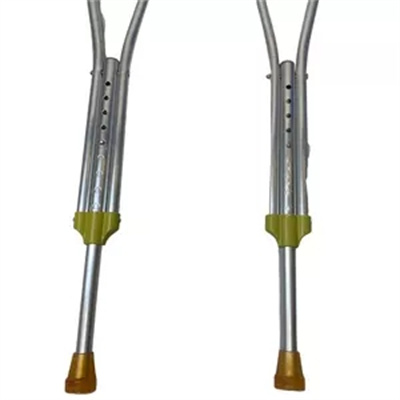Using crutches for kids can be challenging, but with proper precautions and safety measures in place, it can be done safely. Here are some important tips for ensuring the safety of children who need to use crutches:
- Proper Fit: Ensure that the crutches are the right size for the child. The height should be adjusted so that the child’s arms are slightly bent at the elbows when holding the hand grips. The hand grips should also be comfortable to hold.
- Training and Supervision: Children should receive proper training on how to use crutches safely. A physical therapist or healthcare professional can teach them how to walk, stand, sit, and go up and down stairs using crutches. Supervise their use of crutches until they are confident and skilled.
- Non-Slip Tips: Make sure the crutch tips are in good condition and have non-slip rubber grips. Replace worn tips promptly to prevent slipping.
- Footwear: Encourage the child to wear appropriate, supportive footwear that fits well and has a non-slip sole. Avoid open-toed shoes or sandals.
- Clear Walking Paths: Keep walking paths at home and school clear of obstacles, toys, and clutter to reduce the risk of tripping and falling.
- Stair Safety: Teach children how to safely go up and down stairs with crutches. This may involve hopping up or down on one leg or using a step-to-step technique. Supervise them until they are confident on stairs.
- Handrail Use: Whenever possible, encourage children to use handrails when going up or down stairs or ramps for added stability.
- Assistance and Support: Children using crutches may need assistance with certain activities, such as carrying heavy objects or navigating challenging terrain. Encourage them to ask for help when needed.
- Proper Posture: Emphasize the importance of maintaining good posture while using crutches. This includes keeping the back straight and the shoulders level.
- Regular Breaks: Using crutches can be physically demanding, especially for children. Encourage them to take regular breaks to rest and avoid overexertion.
- Weather Considerations: In inclement weather, provide appropriate footwear, such as rain boots, and take extra precautions to prevent slipping on wet or icy surfaces.
- Backpack or Bag: Use a backpack or bag to carry books and personal items, as carrying items in hand while using crutches can be challenging and may affect balance.
- Anti-Slip Mats: Place anti-slip mats in areas where children may encounter wet or slippery surfaces, such as in the bathroom.
- Regular Check-Ups: Schedule regular check-ups with a healthcare provider to monitor the child’s progress and ensure that the crutches continue to fit properly.
- Encourage Communication: Encourage open communication with the child about any discomfort, pain, or difficulties they may be experiencing while using crutches.
It’s crucial to provide emotional support to children using crutches as well. They may face challenges, frustration, or self-consciousness about their mobility limitations. Encourage a positive attitude, offer praise for their efforts, and seek guidance from healthcare professionals and physical therapists as needed to ensure they are using crutches safely and effectively.




















